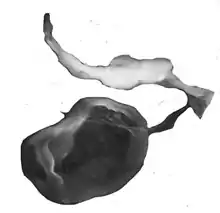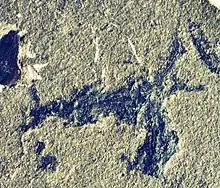Casterlorum
Casterlorum ("Caster's whip") is a genus of hornwort fossil from the Middle Ordovician (Darriwilian, 460 million years old) Douglas Lake Member of the Lenoir Limestone from Douglas Dam Tennessee[1] The genus was named in honor of Ken Caster.

Intepretative sketch of Casterlorum crispum

Slab with multiple specimens of Casterlorum crispum

Spore and elater of Casterlorum crispum
| Casterlorum | |
|---|---|
 | |
| Holotype of Casterlorum crispum, from the Douglas Lake Member of Lenoir Limestone, at Douglas Dam, Tennessee[1] | |
| Scientific classification | |
| Kingdom: | |
| Division: | |
| Class: | |
| Order: | |
| Family: | |
| Genus: | Casterlorum Retallack (2019) |
| Type species | |
| Casterlorum crispum Retallack (2019) | |
Description
Casterlorum has a wide dichotomizing gametophyte thallus with dichotomizing dark lines interpreted as mucilage canals with cyanobacterial symbionts. The sporophyte horns have a thick basal involucre and when dehisced form whip like curls. Spores are small and laevigate.
Biological affinities
"Casterlorum" is similar in its organization and smooth small spores to living Leiosporoceros.
References
- Retallack, G.J. (2019). "Ordovician land plants and fungi from Douglas Dam, Tennessee". The Palaeobotanist. 68: 1–33.
This article is issued from Wikipedia. The text is licensed under Creative Commons - Attribution - Sharealike. Additional terms may apply for the media files.